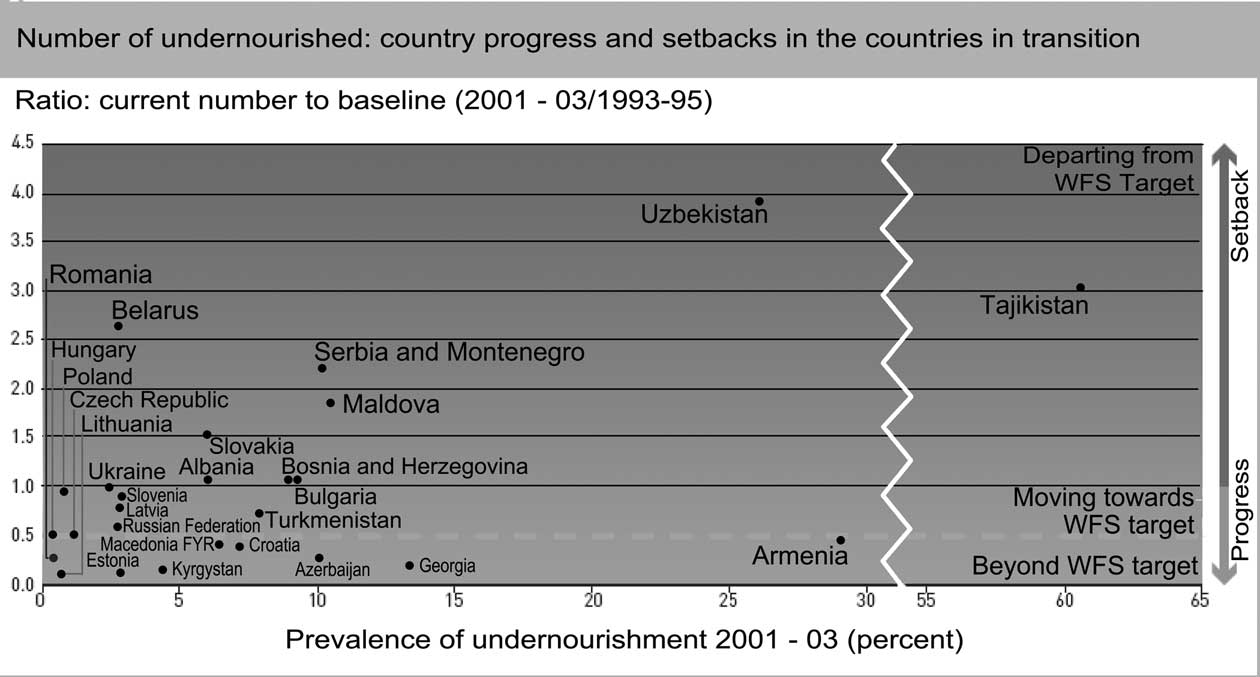
| Previous | Return to table of contents | Search Reports | Next |
| « Back to weltagrarbericht.de | ||
Setting the Stage | 7

Figure 1-4. Prevalence of undernourishment in countries in transition, 2001-2003
raise land prices, thus creating a barrier to beginning farmers. Furthermore, patterns of discrimination in their allocation have prevented minorities from receiving subsidies at the same rate that white male farmers receive them (Oxfam America, 2007). Wageworkers in agrifood systems (e.g., farmworkers, meat-packers, poultry processing workers, waitresses, cashiers in supermarkets) often have incomes below the official poverty threshold, and may face hazardous or substandard working conditions. Farmworkers in the US are excluded from legislation that guarantees rights such as forming trade unions and bargaining collectively. They suffer from low and stagnant wages, job instability, dangerous and unhealthy working conditions and substandard accommodations (Oxfam America, 2004). Undocumented farmworkers are the most vulnerable of all people in the food system, yet they have little recourse in the current political and legal environment. An estimated 10.3 million undocumented workers are in the US, with about 57% from Mexico (Passel, 2005). Migrants to NAE countries frequently work in low-wage agrifood system jobs, but their livelihoods are precarious because of their legal status. In contrast, people involved in management tiers of agribusiness have seen dramatic rises in wealth and power because of policies that created environments conducive to the success of larger businesses reliant on AKST. Agricultural resources and most stages of input production and commodity processing, distribution and retail have become concentrated into fewer, much larger enterprises at an accelerating pace over the past century. Five of the inheritors of the Wal-Mart fortune were among the top thirty wealthiest people in the world in 2006 (Kroll and Fass, 2007). Wal-Mart's Supercenters sell more groceries than any other re- |
|
tailer in the United States, and Wal-Mart has moved rapidly into other countries in NAE and other regions. 1.2.3 Promoting equity across gender and social gaps The proportion of women and minorities that are farmers and work in other sectors of agrifood systems varies considerably across NAE. Women and minorities constitute small proportions of the farm population in most North American and western European countries, but the numbers of women operators have been increasing. For example, in Canada, 27.8% of farm operators were women in 2006 (Statistics Canada, 2006). In the USA, women are 9% of farm operators but 16% of operators of limited resource farms. Minorities account for 5% of all principal operators and a similar percentage for each farm type except for limited-resource farms, of which about 12% have a minority operator (Hoppe et al., 2007). In contrast, women are a large proportion of the population engaged in agricultural production in some of the countries newly acceded to the EU, eastern Europe, and transition countries in the Balkans and the Commonwealth of Independent States. Women tend to be employed at the same or even slightly higher rates than men in agriculture in these countries: 42% of employed women in Moldava were in this sector in 2003 (compared with 44% for men) and 37% in Romania (compared with 35% for men). Women also are more likely to be engaged in subsistence agriculture and agricultural jobs in the informal sector, as their employment rates in the formal sector dropped markedly after the early 1990s (Jacobs, 2006). Women constitute a small minority of migrant farmworkers, but they are particularly vulnerable to exploitation in that occupation. |
| Previous | Return to table of contents | Search Reports | Next |
| « Back to weltagrarbericht.de | ||